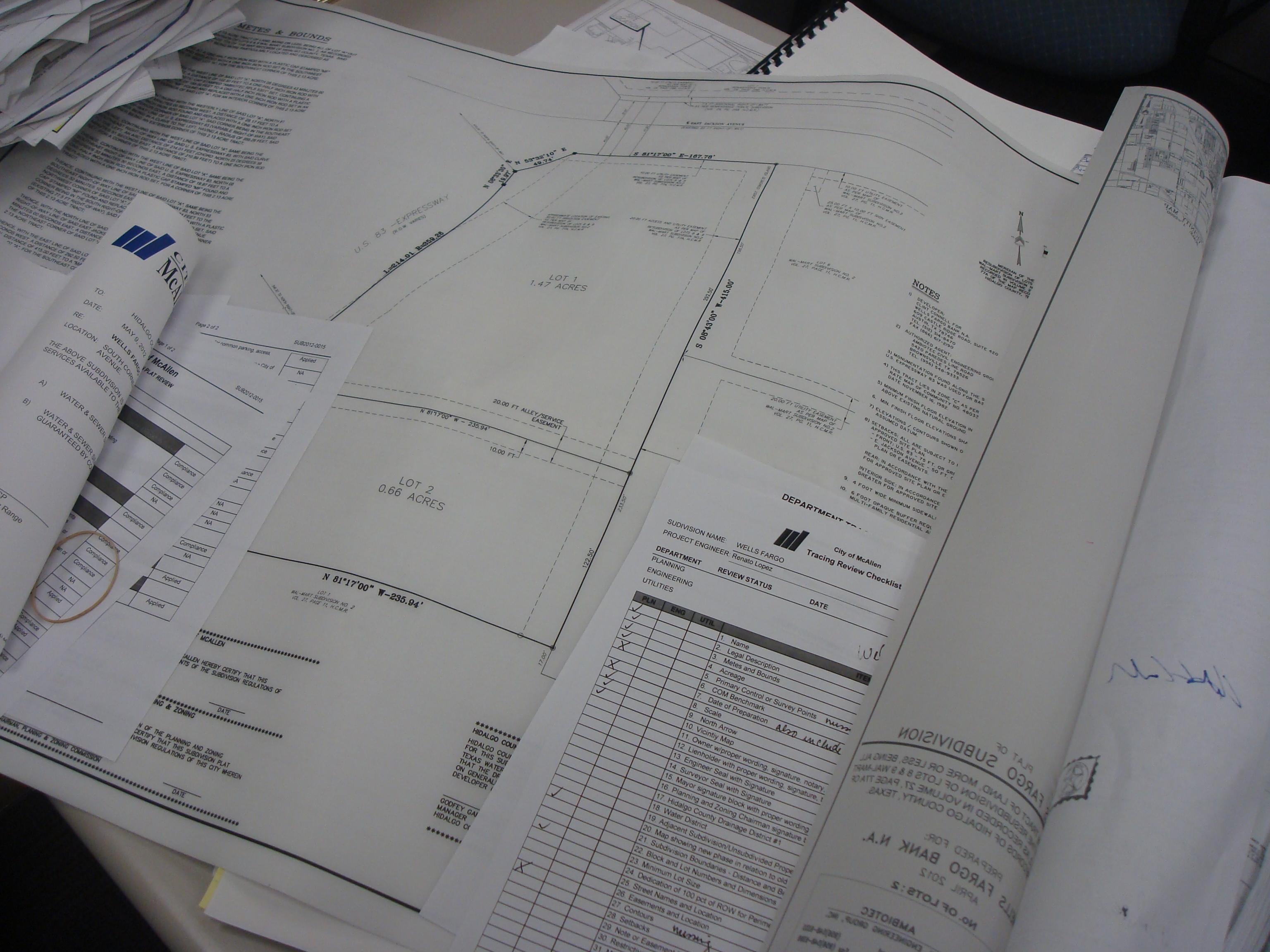
SUBDIVISION REVIEW PROCESS
Subdivision is the process of dividing and splitting a tract of land into separate parcels. The usual purpose of subdividing is to permit the transfer of the subdivided piece to someone other than the owner of the original parcel. Most often a subdivision is done for the purpose of development, such as building a house or developing a commercial or industrial structure.
Any property owner who sells a portion of his property creates a subdivision if the property description is less than the whole lot such as:
- East 1/2 of Lot 1; or
- East 100 feet of Lot 1; or
- East 0.5 acres of Lot 1.
The responsibility of regulating subdivision activity has been delegated to cities and counties by the State of Texas. State law gives cities jurisdiction to regulate the subdivision of land that extends five miles beyond the city’s limit.
The subdivision process determines the city’s responsibility to accept and maintain public improvements. Utilities (water and sewer), fire hydrants, drainage, and streets are planned as part of the subdivision process to connect with existing or proposed developments.
Subdivisions approved by the city are prepared on a plat by a registered professional engineer and recorded in the county map records. A plat is drawn on a plastic film (mylar) and shows a map of the subdivision. This map is properly signed by the owner, engineer, surveyor and local officials.
The owner of a lot shown on a recorded plat may obtain a building permit and connect to a utility company for water supply, sewage disposal, electricity and gas.
Plat Approval Process
A property owner/developer is required to construct street, utility lines, fire hydrants and drainage facilities to city standards in order to obtain plat approval. These improvements are given (dedicated) to the city for future maintenance after inspectors have accepted the improvements.
The property owner may sell lots shown on the plat after the county clerk records the subdivision plat.
Subdivisions Not Requiring a Plat
A tract of land may be exempt from the subdivision process under conditions described below. Certain documentation is required prior to the issuance of a certificate of compliance. Under present subdivision regulations, a certificate of compliance is issued to an owner holding a property description with less than a whole lot in the following cases:
- Warranty deed by present owner was recorded prior to October 15, 1973;
- Building was constructed prior to October 15, 1973;
- Subdivision occupied or in use prior to October 15, 1973; and
- Subdivided tract is 5 acres or more (for agricultural purposes) in the city and 10 acres or more in the county.
Upon the receipt of a certificate of compliance from the Planning Department, a building permit and utility service may be granted. Subdivisions located within 5 miles of the McAllen city limits (McAllen’s Extraterritorial Jurisdiction (E.T.J.)) are regulated by the city to assure:
- An accurate property description;
- Frontage along a public road;
- Adequate drinking water supply;
- Sanitary disposal of sewage; and
- Protection from storm water flooding.
Steps for Plat Approval
In general, the basic steps for obtaining plat approval are as follows:
- Property owner contacts the Planning Department and engages an engineer to prepare a plat;
- Engineer files application after paying a non-refundable fee for a proposed subdivision;
- City departments review proposed plat;
- The Planning and Zoning Commission approves the subdivision in preliminary form;
- The engineering department approves the drainage plans/reports if they are in compliance with city requirements; otherwise City Commission approval is required;
- The McAllen Public Utility Board approves water and sewer services;
- The project engineer submits corrections/changes for the final plat and construction plans;
- The City departments review the plat and construction plans;
- The Planning and Zoning Commission approves the subdivision in final form;
- Property owner constructs improvements or submits a security in lieu of completing developer improvements; and
- The plat is submitted to the County Clerk or to the County Planning Department with a non-refundable fee and drainage review fee.
The County Clerk’s office records the plat with a non-refundable filing fee depending upon plat size and recording documentation.
The cost involved to obtain plat approval varies with the improvements required to service the subdivision. The time involved to obtain a recorded plat depends upon the following:
- The project engineer’s schedule to prepare the plat and construction plans;
- The contractor’s schedule for completing improvements; and
- City review of plans and inspection of improvement/infrastructure.
FREQUENTLY ASKED QUESTIONS
What is a subdivision?
A subdivision is a parcel of land divided from a larger area. The purpose of a subdivision is to take a large tract and split it into smaller ones that are easier to develop and that can be developed independently of one another, increasing growth and maximizing use of space. A subdivision can be one lot or multiple lots.
Why is a subdivision required?
The purpose is to provide for the orderly, safe and healthful development of the area within the city and within the area surrounding the city and to promote the health, safety, morals and general welfare of the community.
At what point can the lots be sold?
The lots can be sold after the final plat approval has been granted by the City, final documents submitted and approved by the City including a mylar copy of the subdivision, and recorded in the deed records of the Hidalgo County Clerk’s Office.